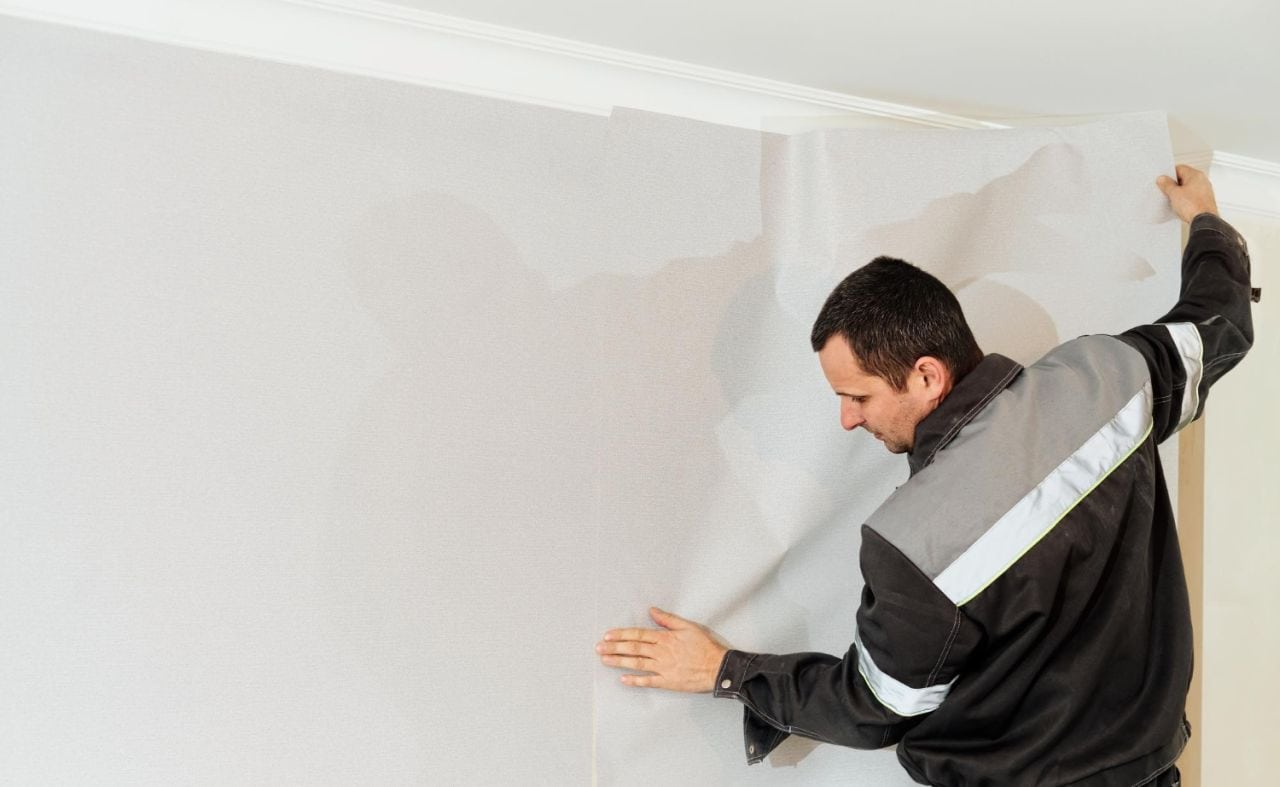Plaster walls are a common feature in older homes, admired for their durability and excellent soundproofing. Painting these walls can be challenging due to their unique texture and required preparation.
The right choice of paint and finish can significantly affect the room’s appearance and atmosphere. Here’s a guide to help you choose the best paint colours and finishes for plaster walls.
Let’s get straight to the point.
Choosing the best colour for plaster walls depends on the room’s atmosphere and style preferences. Neutral colours like beige, grey, and white are versatile and create a timeless, elegant look.
Earthy tones (e.g., terracotta, sienna) add warmth and a natural vibe, while jewel tones (emerald green, sapphire blue) bring drama and sophistication. Pastel shades offer a calming, elegant touch, ideal for private spaces.
Consider using water, oil, or latex paints and finishes like matte or satin to match durability needs when painting plaster. Proper preparation, technique, and maintenance are key to achieving a smooth, long-lasting finish.
Best Colours For Plaster Walls

Choosing the right colour for plaster walls can significantly influence the room’s mood and highlight the natural texture of the walls.
Some colour options work exceptionally well with plaster surfaces and ideas for incorporating them into your space.
1. Neutral Colours
Neutral colours are a classic choice for plaster walls. They enhance the room’s openness and elegance and create a versatile backdrop in almost any setting.
Some popular neutral shades include:
- Beige
- Grey
- White
Benefits Of Neutral Colours:
- Light Reflection: Neutrals reflect natural and artificial light, making rooms appear larger and brighter.
- Versatility: They blend seamlessly with various décor styles, from modern to traditional.
- Timeless Appeal: Neutral colours stay in style, ensuring your walls stay relevant and fresh.
Ideas For Using Neutrals:
- Combine shades of grey or beige to add subtle depth and dimension to the room.
- Use a crisp white for a clean, minimalist look, perfect for contemporary settings.
2. Earthy Tones
Earthy tones bring warmth and a sense of nature into your home. These colours have an
organic feel that pairs beautifully with the texture of plaster.
Consider the following earthy shades:
- Terracotta
- Ochre
- Sienna
Benefits Of Earthy Tones:
- Warm Ambiance: Earthy colours create a cosy and welcoming atmosphere, ideal for family rooms or dining areas.
- Natural Connection: These shades evoke a connection to nature, grounding the space and adding a touch of rustic charm.
Ideas For Using Earthy Tones:
- Pair terracotta walls with wooden furniture and greenery to enhance the natural vibe.
- Use sienna as an accent colour to highlight architectural features or textured areas on the wall.
3. Jewel Tones
Jewel tones add a touch of glamour and drama to plaster walls, creating a bold statement that draws the eye. These colours work best in accent areas or smaller spaces where they can stand out.
Some jewel tones to consider include:
- Emerald Green
- Sapphire Blue
- Ruby Red
Benefits Of Jewel Tones:
- Sophisticated Look: These shades bring any room an elegant, opulent feel.
- High Impact: Jewel tones have a rich, intense quality, making them perfect for creating feature walls or focal points.
Ideas For Using Jewel Tones:
- Paint a single wall in sapphire blue to create a dramatic accent in a study or reading nook.
- Use emerald green in a hallway or entrance to make a grand first impression.
4. Pastel Colours
Pastel shades offer a soft, calming effect that complements the textured surface of plaster walls. They are ideal for creating a serene and gentle environment, especially in private spaces. Some lovely pastel colours include:
- Lavender
- Blush Pink
- Pale Blue
Benefits Of Pastel Colours:
- Soothing Effect: Pastels are calming and suitable for bedrooms and relaxing areas.
- Elegant Touch: These shades add a subtle touch of sophistication without
overwhelming the room.
Ideas For Using Pastel Colours:
- Combine pale blue walls with white trim to create a fresh, airy look in bathrooms or bedrooms.
- Use blush pink in children’s rooms for a soft, playful touch that can easily adapt to different themes.
Additional Colour Ideas For Plaster Walls
To further personalise your space, here are a few more ideas that work exceptionally well with plaster:
1. Two-Tone Colour Schemes
- Upper and Lower Wall Contrast: Divide the wall into two sections, with a darker tone on the lower half and a lighter shade on the top. This approach adds visual interest and depth.
- Complimentary Combinations: Pair neutrals with earthy or jewel tones for a balanced, sophisticated, and inviting look.
2. Monochromatic Themes
- Shades of a Single Colour: Use shades of the same colour to highlight the plaster’s texture without making it too bold. For example, combine light grey with charcoal accents.
- Textured Finishes: Incorporate textured paint techniques to enhance the natural feel of the plaster walls, like a subtle stucco effect.
Tips For Choosing The Right Colour
When selecting a colour for your plaster walls, keep these points in mind to make the best choice:
- Lighting Matters: Always test your chosen colour in different lighting conditions. Natural and artificial light can change how a colour looks on plaster.
- Room Functionality: When choosing a colour, consider the room’s purpose. Calming colours work well in bedrooms, while vibrant tones are better suited to social areas.
- Test Samples: Before deciding, paint small wall sections with different colours. This will help you see how each shade interacts with the plaster’s texture.
Types Of Paint For Plaster Walls
When choosing paint for plaster walls, it’s essential to consider the paint that works best with the material. Some of the most common options include:
- Water-based paints are ideal for freshly plastered walls, as they allow the plaster to breathe and dry together with the paint.
- Oil-Based Paints: Offer a durable finish but require a primer to help them adhere to the plaster surface.
- Acrylic Latex and Latex Paints: These are flexible, easy to apply, and work well on plaster walls.
Choosing The Right Paint Finishes For Plaster Walls

The finish of the paint you choose affects your walls’ visual appeal and durability. Here are some popular choices for plaster walls:
- Matte Finish: Great for hiding imperfections, offering a subtle, non-reflective surface.
- Eggshell Finish: This finish provides a low sheen with a slight gloss, making it easier to clean than matte finishes.
- Satin Finish: Adds a soft shine, ideal for living rooms and bedrooms.
- Semi-Gloss Finish: Highly reflective and durable, suitable for kitchens and bathrooms.
- Gloss Finish: Best for high-traffic areas like doors and trim due to its resilience and easy maintenance.
Painting Techniques For Plaster Walls
Achieving a smooth finish on plaster walls requires careful application. Here are some tips to consider when painting plaster surfaces:
- Use Thin Coats: Apply paint in thin layers to prevent drips and ensure proper adhesion to the plaster.
- Vary Brush Strokes: Mix long and short strokes to cover the textured surface without leaving visible lines.
- Wait Between Coats: Allow each coat to dry completely before applying the next to avoid smudging or streaks.
Common Mistakes To Avoid
When painting plaster walls, it’s easy to make mistakes that can affect the final result. Here are some pitfalls to watch out for:
- Skipping the Primer: Failing to prime plaster walls can lead to poor paint adhesion and peeling.
- Not Sanding the Surface: Smooth plaster walls should be lightly sanded to give the paint something to grip.
- Using the Wrong Paint: Avoid using paints not suitable for plaster, as they may not adhere well or could cause issues with the finish.
Maintaining Painted Plaster Walls
To keep plaster walls looking their best, consider these maintenance tips:
- Regular Cleaning: Clean the surface with a soft cloth to remove dust and dirt.
- Touch-Up: Address chips or cracks immediately to prevent them from spreading.
- Repaint as Needed: High-traffic areas may need a fresh coat to maintain their appearance over time.
Conclusion
Painting plaster walls can be a rewarding project if done correctly. The key is to choose the right paint, prepare the surface thoroughly, and use suitable finishes.
Neutral, earthy, jewel, and pastel tones all work beautifully with the texture of plaster, each creating a distinct atmosphere.
By following these guidelines and avoiding common mistakes, you can achieve a stunning result that brings out the best in your plaster walls.
Whether renovating an old home or adding a fresh look to your interiors, a carefully chosen colour and finish can transform the space into something truly special.
Frequently Asked Questions About Plasterer
Which type of plastering is best?
Exterior walls are best plastered with cement plaster due to its resistance to moisture, which helps to shield the wall from the effects of climate change and pollution. In addition, cement plaster’s durability makes it a great option for both exterior and interior applications.
How many layers of plaster should be used?
In order to achieve a professional-looking sheen, you’ll need to apply at least two coats. After the second coat has dried, check for obvious grooves and indents; if there are any, trowel on a third.
What are the defects in plastering?
Plastering work often has issues like blistering, cracking, efflorescence, flaking, peeling, popping, softness, and uneven surfaces. As soon as these plastering flaws are spotted, they must be fixed.
How can plastering defects be prevented?
Preventative measures include selecting appropriate materials and following standard construction procedures, as well as proper preparation and cleaning of the wall surface. Plasterwork is less likely to delaminate when the wall surface is clean and properly prepared for the application of the plaster.
What is the ideal temperature for plastering?
Ventilation, temperature, and humidity levels must all be taken into account to guarantee productive work environments. Plaster should be applied in temperatures between 60 and 70 degrees Fahrenheit (at least 55 degrees Fahrenheit) and relative humidities that correspond to normal drying conditions.

